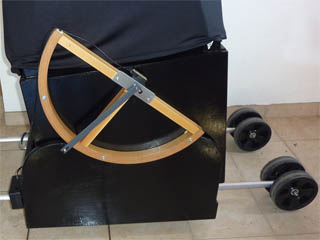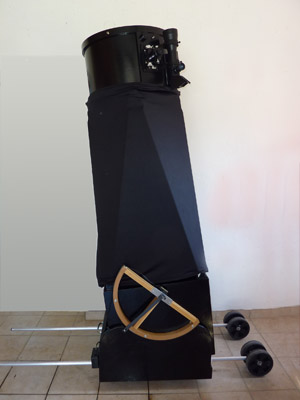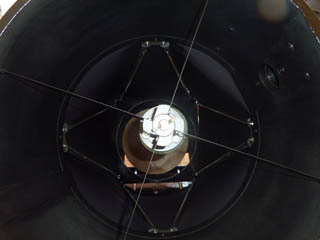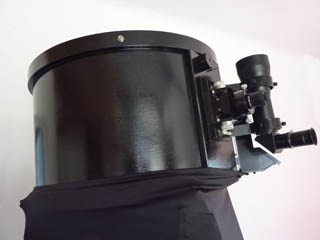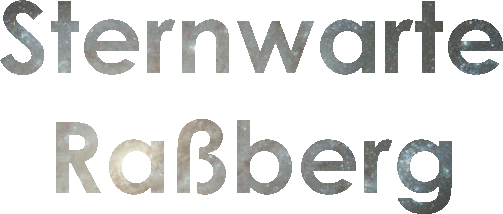Visual Astronomy
Lukehurst 20" f4.0 Dobson
The astronomy bug had been biting and I had been giving some thought to buying a scope purely for visual use. The plan was, all equipment in my observatory to be purely for photography, and then have an additional scope for visual work.
I don’t think I spent a lot of time deciding what type of scope, it seemed sensible to go for something big and the dobson construction offers the best combination of scope for money.
I also liked the idea of staying with Newtonian optics, I was familiar with these and had no problems with collimation and such. Whilst searching, I obviously stubbled on the Rolls Royce of Dobs, Obsession Telescopes of the USA. They seemed great, just very expensive, but none the less a bench mark. I did find an importer in Switzerland, but they were a) very expensive and b) I reckoned with major tax and customs problems. I did also contact Obsession direct in the USA, they were very helpful and even offered me their products much cheaper than I expected. However, again shipping, customs and tax killed the deal, just too expensive.
Whilst searching, I also came across a report in Cloudy Nights, a guy in Slovenia ( not far from here ) reported on a lightweight Lukehurst Dobson he had bought, and compared its build quality to that of the Obsessions.
This report awoke my interest and I contacted Dave Lukehurst. He is a really friendly guy, has a lot of experience and was very willing to give advice. I spent some months corresponding with him and trying to narrow down my decision as to what I wanted, and basically he was very helpful when it came to this. This was my basic specification :
18” or 20” standard Dobson – ultralight was not important, but stabilty more so
I opted for the 20” and 1/10 lamda Oldham Optics
A good focuser
The Moonlight soft touch
Both a finder scope and telerad – not a problem
Digital setting circles
I considered ArgoNavis, this was possible but Dave told me there are difficulties getting stuff from Australia and recommended the SkyCommander from the UK. I took this advice and frankly despite the fact that on paper it’s a bit old fashioned, I am very happy with it.
A cloth shroud
Dave doesn’t offer this as standard, but has contacts in the US who make these to measure. For me it was important as general protection, dust protection and for cutting out stray light. The finished shroud was first class and not expensive.
Bolt on wheelbarrow handles as narrow as possible.
Dave offered to modify the aluminium slip thru poles from the ultralight to work on the standard rockerbox. Mine was the first – and it works a dream.
Additional counterweights on the focuser for the eventuality that I at some stage have heavy equipment eg a camera
Before placing my order, my very first question was, if the dob could be delivered to my home in Austria. Dave informed me that theoretically he could ship anywhere in the world, but had had a lot of misfortunes using couriers and was prepared to do anything in order to deliver personally. He mentioned that he often took scopes for customers in France to Calais and met the owners there. After some discussions we agreed on a pesonal meet somewhere in central France. I should mention that Dave did this on a strictly cost basis - only for fuel and ferries, not the time and effort involved. On this front, this rates as perfect customer service.
Also before ordering, I wanted to get some hands on experience with a dob. By chance I found a website in southern Styria from a guy who gives public star parties at local vineyards. I contacted him and spent a few evenings with his 450mm Martini Dobson. After this, I had fewer reservations about my purchase.
So, after a number of months planning, I made my order in April 2009. I had hoped to receive my scope in July or August and had planned to drive to the UK and combine the trip with a holiday. Unfortunately, there were major delays in Oldham getting the glass blanks for the main mirror and the scope was not completed until the end of October. Having said this, Dave kept me regularly informed of the status and in fairness, neither he nor Oldham could do very much to speed things up. When the blanks were eventually received, both parties pulled out the stops to atleast minimise any further delays.
Shortly afterwards, after a long drive to France, I was the proud owner of a 20” Lukehurst Dobson. So, how do I rate it, what are its good and bad points.
Well, generally I rate the telescope very highly. It is solidy built, all componants are vey good quality. The only bad point ( well, not a bad point, but something I overlooked ) is that the rockerbox is very high and this makes transport in some cars a problem. I have a Vectra estate, by no means small, but we almost didn’t fit it in to the boot because of the limited headroom at the tailgate.
I mentioned previously the SkyCommander. I was a little hesitant at going for a rather old fashioned piece of electronics. I can only say after using it, I am so happy I did buy this. Calibration takes literaly 2 Minutes, there are ample calibration stars to use, even ones that I can find. I usually have a 13mm Hypperion in the focuser ie some 150x magnification – todate I have not once looked for an object and not got it on the first try in the FOV. For the most part the catalogues within the SC are more than adequate. Typing in coordinates of say a comet is dead easy. Hooking up to a PC is a little more demanding and not so straight forward, but rarely needed. I now also use SkyTools3 and this downloads lists and coordinates with ease and the push of a button.
I use my dob at almost every opportunity, I really have taken to it. In my old GSO 200mm f4 Newton, galaxies such as M82 were just a smear, in the 20” they are enormous and full of detail. Nebulas are also terrific, especially with nebula filters. My favorites are the Orion Nebula and the Cirrus Nebula.
One minor downside, the giggantic primary mirror is not suitable for really bright objects. I thought I had dammaged my eye looking at the moon once and hence made an aperture mask from cardboard ( 15cm diameter ). This really helped, also for the planets. I once tried splitting epsilon lyr, the double double, but to no avail. I was a little disapointed, I must admit. Then a friend, who is 80 years old and has more wisdom and knowledge of astronomy than I ever will, told me that this too was because the large mirror let in too much light. I tried again with my mask and bingo, a perfect split.
I have now had my dob for one year and am very happy with it. My one wish since owning it, was to go mobile with my friend Klaus and his 450mm Martini Dobson and go up a mountain with both scopes. Actually, within on hour from here, there are isolated areas with good access at over 2000m. Sadly, so far we have not achieved this, but one day we will.
So, finally the big question, would I recommend buying a Lukehurst Dobson ? Answer : without a doubt. Just take a look at the price of say the 16” GSO – it is certainly cheaper, but at what cost I ask. The mirrors would certainly be ok but the Lukehust Dob has high quality mirrors. As for the construction, no comparison, I reckon after 2-3 years the pressed woodchip on the GSO would simply start to fall apart. Dave Lukehurst not only builds his scopes uniquely, he caters for every need and in giving advice is very straightforward and honest. The fact that Dave is in England ie the EU was a major factor for me, this meant absolutely no problems with taxes or customs.
Below are some photos of my beast

